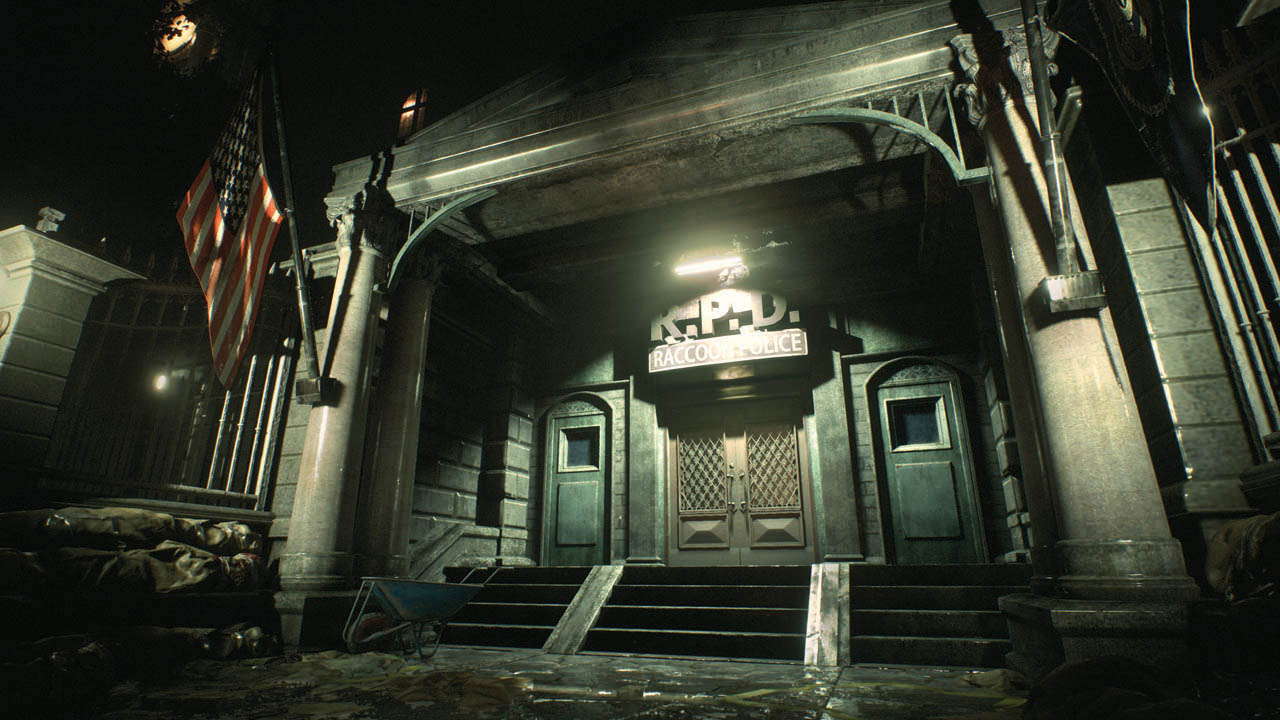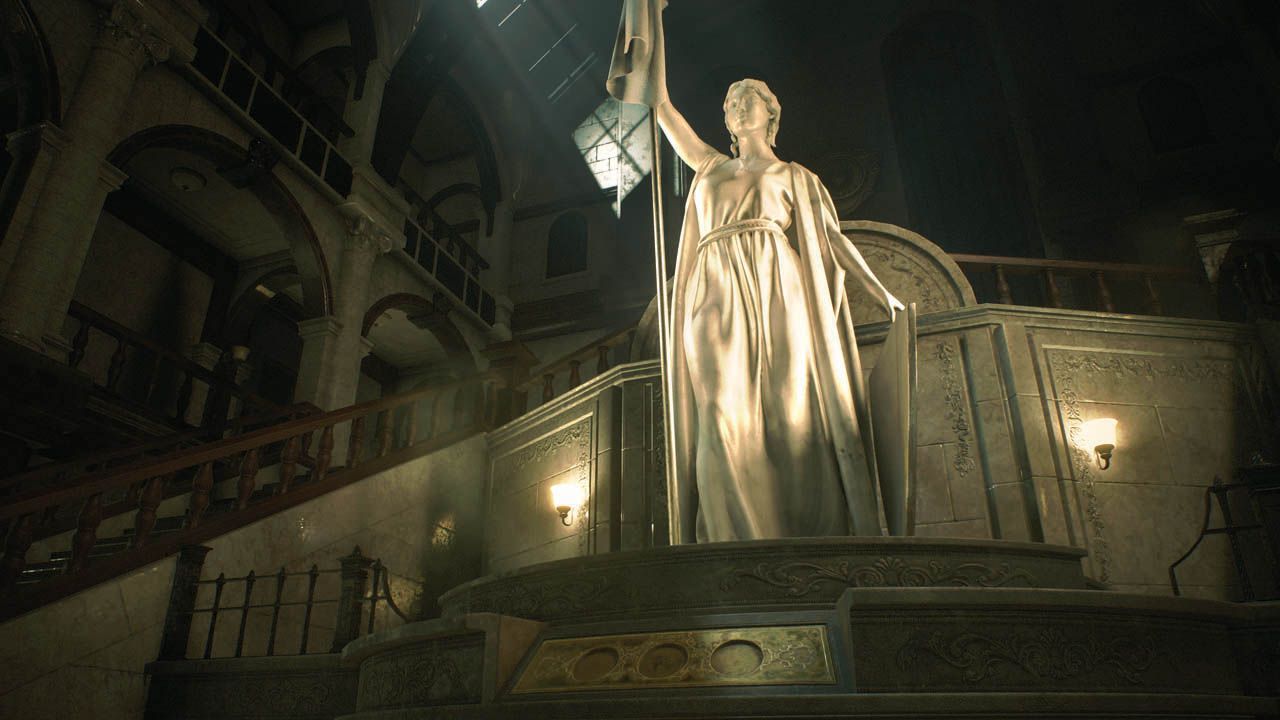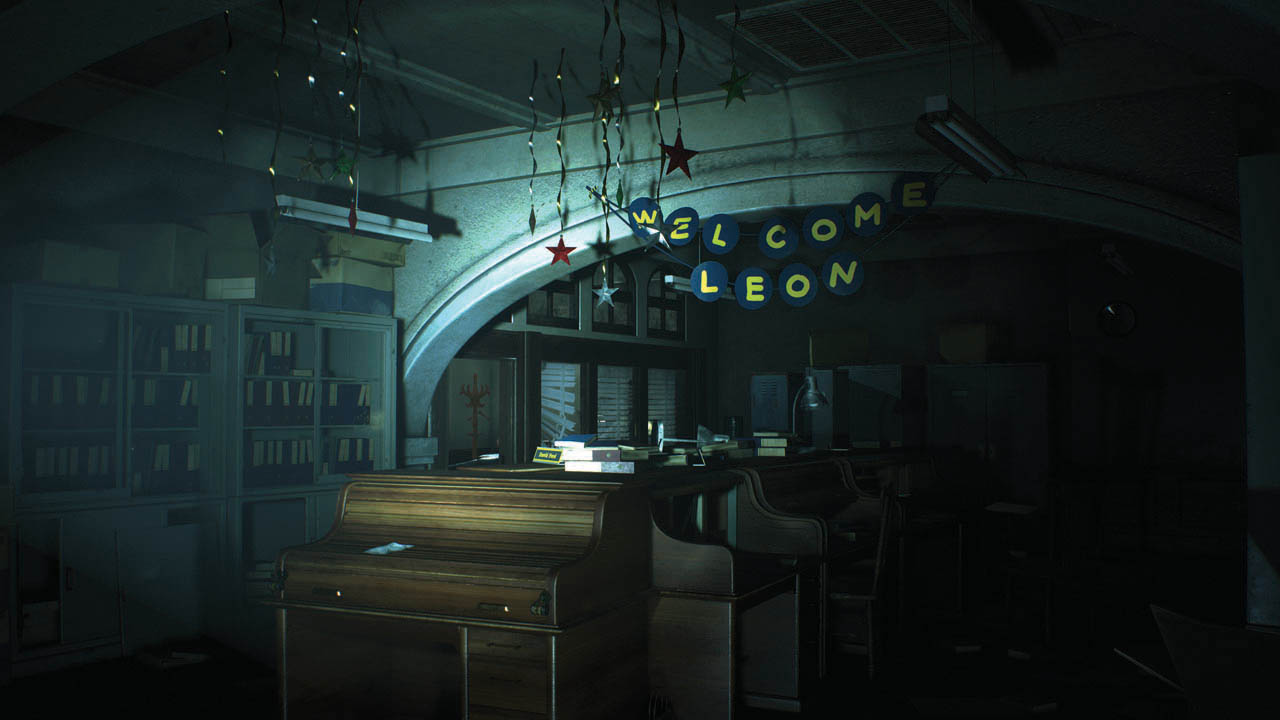The making of Resident Evil 2 Remake's Raccoon City Police Department
How Capcom reimagined the iconic Resident Evil 2 location.

This feature originally ran in issue 332 of PC Gamer magazine. If you'd like to read more great features like this, consider subscribing.
Drive north from Capcom's headquarters in downtown Osaka, along the Tosabori River, and in about 20 minutes you'll see a unique red-bricked building with a domed roof. This is the Osaka City Central Public Hall, one of the city's most beloved buildings and part of the inspiration for the Raccoon City Police Department in Resident Evil 2. This iconic setting, which fans count among the series' best, was confidently reimagined in the 2019 remake, and this is the story of how it was designed.
Enter the Central Public Hall, which was built in 1918 and is an important cultural centre for the city, and you'll find polished floors, towering pillars, ornate detailing, and a vast church-like ceiling—the same kind of grand architecture Leon and Claire see when they escape the zombie-ravaged streets of Raccoon City and enter the RPD's impressive main hall. All that's missing are the blood splatters and groans of distant zombies.
Capcom's long-awaited Resident Evil 2 remake is a masterclass in updating an old game for a new audience. It retains the spirit of the PlayStation original, released in 1998, but uses modern technology to make it feel genuinely new and exciting. An important part of the remake's success is the newly realised RPD building—a setting that's just recognisable enough to feel like the same place, but much more evocative and atmospheric.

"Our goal was retaining the feel of the original building, but also to increase the sense of scale and realism," says Resident Evil 2 remake director Kazunori Kadoi. "I was confident players would respond well to this, and I didn’t feel any particular pressure to live up to the original game."
Although the original main hall was a flat pre-rendered image, and the new one is fully rendered in 3D, they both create the same feeling of dread and mystery—that this might not be the safe haven the characters were expecting after all.
Kadoi explains that the architecture of the station, both in the original and the remake, was inspired by the Gothic revival style. Popularised in the west in the 1700s, this architectural movement was an attempt to revive medieval Gothic architecture—particularly in religious buildings. And there's a definite cathedral-like feel to the RPD main hall, which could easily double as a place of worship if you inserted a few rows of pews.
Keep up to date with the most important stories and the best deals, as picked by the PC Gamer team.
Culture shock

There's also an uncanny quality to the station that I think comes from Raccoon City, an American city, being viewed through a Japanese lens. If the station had been designed by a western studio—one that is perhaps more familiar with the kind of bland government building police departments usually operate out of—it might not have been quite so idiosyncratic and memorable. I mean, how many police stations do you know with a giant marble statue of a goddess behind the reception desk?
This statue is something Kadoi felt was important to bring back, as well as the eerie stuffed animals found in the office of the corrupt Chief Irons. The statue is noticeably bigger in the remake, dramatically lit by moonlight streaming through glass windows in the ceiling. "I wanted to carry the statue and the taxidermy animals over to the new police station,” he says. "But at the same time I wanted to make changes that would make the gameplay more fun, and make the station feel more like a believable space."
Kadoi explains that, because of advances in graphics technology and player expectation, videogame settings have to be more believable today. When I first played Resident Evil 2 as a teenager, I never questioned the fact that the RPD was headquartered in an elaborate old building filled with arcane puzzles. But these days, Kadoi says, people question this stuff more, which led to additional backstory being written for the station.

"The building in the centre of town wasn't always a police station," reads a tourism pamphlet you can pick up in a waiting room. "In fact, it used to be an art museum. Various features like the unusual clock tower and the goddess statue in the main hall remind us of a bygone era." This idea is also reinforced by the oil paintings, old statues, and other artefacts you find littered around the station—often in storage rooms with dust sheets draped over them. Wherever you look there are clues to the building's past.
"The RPD main hall has some weird gimmicks, like hidden passages that wouldn’t be conceivable in a normal police station," says Kadoi. "So I think positioning them as part of a more attraction-oriented space such as a museum or gallery makes that more convincing and believable within the game world." Of course, a lock-and-key system based around playing card suits is still weird, even for an old building like this, but it's a little less distracting thanks to this added touch of world-building.
Another important design element for the new station was, despite the shift to an over-the-shoulder camera, keeping the same feeling of suspense created by the original’s fixed camera angles. "Creating a sense of space you can't see into was part of the fixed camera angle system in the original game," says Kadoi. "But in the remake we used blind corners and darkness to set up a similar feeling, as well as directional audio to give you a sense that there is something out there, but you can’t see where it is yet."
Light source

One of the most dramatic differences between the 1998 and 2019 police stations is the use of lighting. For the most part, the original station is brightly lit. But in the remake, many of its corridors and rooms have been plunged into darkness, forcing you to use a flashlight. This makes it a much scarier place to explore, particularly when you're turning one of those blind corners in the dark. For this aspect of the station's design, Kadoi tells me that the two key words for the artists were "darkness" and "wetness".
"We wanted to create that feeling of something glistening in the dark," he says. "This gives players a sense of a hidden presence waiting for them out of sight." This curious visual philosophy is felt all over the station, whether it’s a corridor partly flooded by a leaking water pipe, or the gruesome glistening effect when your flashlight catches a pool of crimson-coloured congealed blood. These effects are also a showcase for the impressively natural lighting effects that Capcom's in-house RE Engine is capable of.
Playing the game, there is a sense that the building has been designed with a survival horror videogame firmly in mind. There are more blind corners and narrow, winding corridors than would make sense in a real building. But it doesn't dampen the authenticity of the setting, thanks to the fidelity of the visuals and the cinematic use of light and shadow.

A less obvious, but still important, design element was evoking the game's late '90s setting. Overall it's quite subtle with its references to the time period, even taming Leon's 'curtains' hairstyle, making him look less like a member of a boy band. But there are a few clues scattered around that remind you of when the action takes place. "The most obvious example is the computers," says Kadoi. "They are the kind of bulky beige monitors that were common at the time. There are some other small period-accurate props scattered throughout the station that tie into the setting too."
Fan favourite
There are a lot of reasons why the RPD building is a great setting. The way it's built around a central hub, which helps you build a mental map as you play. The gorgeous architecture and moody, atmospheric lighting. The nostalgia hit you get if you played the original. The tension-breaking moments of calm, suddenly interrupted by an unexpected zombie tumbling through a window. The way it subverts your expectations, such as when zombies appear in the main hall, your precious safe haven, in the B scenario. And, of course, the looming presence of the Tyrant.
I ask Kadoi why he thinks the police station is such a beloved setting among Resident Evil fans—and what makes it unique. “Police stations are places we see a lot in movies and TV, so they feel real to us,” he says. "But they weren't used as often in games at the time Resident Evil 2 was released, which made it quite a novelty. But mainly I think it’s the idea that police officers, whose job it is to protect citizens, have transformed into zombies. There's something very impactful and ironic about that."
If it’s set in space, Andy will probably write about it. He loves sci-fi, adventure games, taking screenshots, Twin Peaks, weird sims, Alien: Isolation, and anything with a good story.


